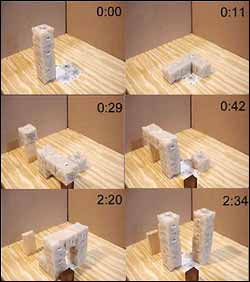Simple but seminal: Cornell researchers build a robot that can reproduce

Frames from a video show the replication process. A robot consisting of a stack of four cubes begins by bending over and depositing one of its cubes on the table. The remaining three cubes pick up additional cubes from "feeding stations" and transfer them to the new robot, which assists in the process by standing itself up.
One of the dreams of both science fiction writers and practical robot builders has been realized, at least on a simple level: Cornell University researchers have created a machine that can build copies of itself.
Admittedly the machine is just a proof of concept — it performs no useful function except to self-replicate — but the basic principle could be extended to create robots that could replicate or at least repair themselves while working in space or in hazardous environments, according to Hod Lipson, Cornell assistant professor of mechanical and aerospace engineering, and computing and information science, in whose lab the robots were built and tested. Lipson and colleagues report on the work in a brief communication in the May 12 issue of Nature.
Their robots are made up of a series of modular cubes — called “molecubes” — each containing identical machinery and the complete computer program for replication. The cubes have electromagnets on their faces that allow them to selectively attach to and detach from one another, and a complete robot consists of several cubes linked together. Each cube is divided in half along a long diagonal, which allows a robot composed of many cubes to bend, reconfigure and manipulate other cubes. For example, a tower of cubes can bend itself over at a right angle to pick up another cube.
To begin replication, the stack of cubes bends over and sets its top cube on the table. Then it bends to one side or another to pick up a new cube and deposit it on top of the first. By repeating the process, one robot made up of a stack of cubes can create another just like itself. Since one robot cannot reach across another robot of the same height, the robot being built assists in completing its own construction.
Although these experimental robots work only in the limited laboratory environment, Lipson suggests that the idea of making self-replicating robots out of self-contained modules could be used to build working robots that could self-repair by replacing defective modules. For example, robots sent to explore Mars could carry a supply of spare modules to use for repairing or rebuilding as needed, allowing for more flexible, versatile and robust missions. Self-replication and repair also could be crucial for robots working in environments where a human with a screwdriver couldn’t survive.
Self-replicating machines have been the subject of theoretical discussion since the early days of computing and robotics, but only two physical devices that can replicate have been reported. One uses Lego parts assembled in a two-dimensional pattern by moving along tracks; another uses an arrangement of wooden tiles that tumble into a new arrangement when given a shove.
Exactly what qualifies as “self-replication” is open to discussion, Lipson points out. “It is not just a binary property — of whether something self-replicates or not, but rather a continuum,” he explains. The various possibilities are discussed in “A Universal Framework for Analysis of Self-Replication Phenomena,” a paper by Lipson and Bryant Adams, a Cornell graduate student in mathematics, published in Proceedings of the European Conference on Artificial Life, ECAL ’03, September 2003, Dortmund, Germany.
For example, the researchers point out that human beings reproduce but don’t literally self-replicate, since the offspring are not exact copies. And in many cases, the ability to replicate depends on the environment. Rabbits are good replicators in the forest, poor replicators in a desert and abysmal replicators in deep space, they note. “It is not enough to simply say they replicate or even that they replicate well, because these statements only hold in certain contexts,” the researchers conclude. The conference paper also discusses the reproduction of viruses and the splitting of light beams into two identical copies. The analysis they supply “allows us to look at an important aspect of biology and quantify it,” Lipson explains.
The research team includes mathamatics graduate student Bryant Adams, left, Hod Lipson and mechanjical engineeering graduate student Victor Zykov. “Although the machines we have created are still simple compared with biological self-reproduction, they demonstrate that mechanical self-reproduction is possible and not unique to biology,” the researchers say.
Co-authors of the Nature communication are Viktor Zykov, a graduate student in mechanical engineering, Efstathios Mytilinaios, a former graduate student in computer science now at Microsoft, and Adams.
Media Contact
More Information:
http://www.news.cornell.edu/stories/May05/selfrep.ws.htmlAll latest news from the category: Power and Electrical Engineering
This topic covers issues related to energy generation, conversion, transportation and consumption and how the industry is addressing the challenge of energy efficiency in general.
innovations-report provides in-depth and informative reports and articles on subjects ranging from wind energy, fuel cell technology, solar energy, geothermal energy, petroleum, gas, nuclear engineering, alternative energy and energy efficiency to fusion, hydrogen and superconductor technologies.
Newest articles

ASXL1 Mutation: The Hidden Trigger Behind Blood Cancers and Inflammation
Scientists show how a mutated gene harms red and white blood cells. LA JOLLA, CA—Scientists at La Jolla Institute for Immunology (LJI) have discovered how a mutated gene kicks off…

Recharging the Future: Batteries Built for Extreme Cold Using Negative Thermal Expansion
Most solids expand as temperatures increase and shrink as they cool. Some materials do the opposite, expanding in the cold. Lithium titanium phosphate is one such substance and could provide…

Self-Destructing Cancer Cells: Cutting-Edge RNA Breakthrough
Jülich scientists use novel RNA technology to selectively switch off tumours in the brain. An Adaptable Platform Technology That Destroys Glioblastoma Cancer Cells Using a special RNA molecule, a team…



